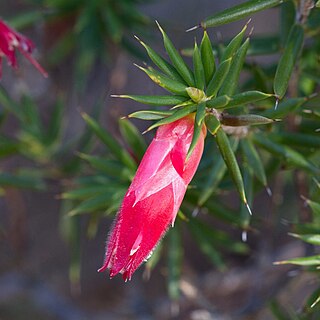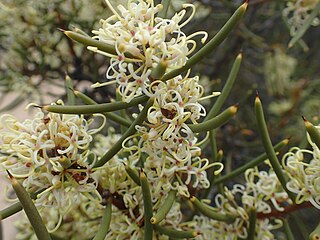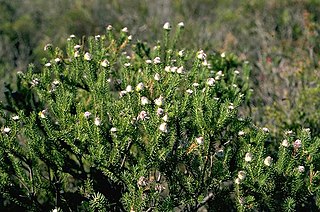Johann August Ludwig Preiss was a German-born British botanist and zoologist.

Taxandria juniperina commonly known as wattie, native cedar, Warren River cedar or juniper myrtle is a species of tree that grows in the south west corner of Western Australia. This plant was previously classified as Agonis juniperina but is now part of the genus Taxandria. The Noongar peoples know the tree as watti.
Western Australia has relatively few species of moss; the most recent census found just 192 taxa. This represents just 10% of Australia's total moss flora, even though Western Australia accounts for about one third of the Australia by area. This relatively low diversity has been attributed to the lack of rainforest in the state.
Ilma Grace Stone, née Balfe, was an Australian botanist who specialised in bryology. She was an author, collector, and researcher of Australian mosses, a subject on which she lectured and wrote.
Wurmbea monantha is a perennial herb that is native to Western Australia. The white to pink flowers are produced between July and September in its native range.

Lasiopetalum baueri, commonly known as slender velvet bush, is a species of flowering plant in the family Malvaceae and is endemic to south-eastern Australia. It is a small, greyish shrub with more or less linear to narrowly oblong or narrowly elliptic leaves and groups of white or pink flowers.

Stenanthera conostephioides, commonly known as flame heath, is a species of small shrub that is endemic to south-eastern continental Australia. It has linear to lance-shaped leaves, red, tubular flowers and green, oval fruit turning dark red.

Grevillea huegelii, commonly known as comb spider-flower or comb grevillea, is a species of flowering plant in the family Proteaceae and is endemic to southern continental Australia. It is an erect to low-lying shrub with divided leaves with mostly three to eleven sharply-pointed linear lobes, and clusters of red to pink flowers that are silky-hairy on the outside.

Hakea preissii, commonly known as the needle tree, needle bush and Christmas hakea, is a shrub or tree of the genus Hakea native to Western Australia. The Noongar name for the plant is Tanjinn.

Grevillea bracteosa, also known as bracted grevillea, is a species of flowering plant in the family Proteaceae and is endemic to the south-west of Western Australia. It is an erect to spreading shrub usually with linear leaves, and oval to more or less spherical clusters of glabrous pale green to greenish-pink flowers with a pink or white style.

Grevillea monticola is a species of flowering plant in the family Proteaceae and is endemic to the south-west of Western Australia. It is a spreading to erect shrub with toothed to pinnatifid leaves with sometimes branched clusters of pale cream-coloured to yellowish-cream flowers.

Kunzea pauciflora, the Mount Melville kunzea, is a species of flowering plant in the myrtle family Myrtaceae, and is endemic to a small area on the south coast of Western Australia. It is a shrub with the stems densely branched near their ends, linear leaves and one, two or three pink flowers near the ends of the branches but usually only at the top of the shrub.

Tortula is a genus of mosses in the family Pottiaceae.

Petrophile scabriuscula is a species of flowering plant in the family Proteaceae and is endemic to southwestern Western Australia. It is a dense, prickly shrub with sharply-pointed, needle-shaped leaves more or less pressed against the branchlets, and oval heads of hairy, yellow to creamy-yellow flowers.

Pterostylis turfosa, commonly known as the bearded bird orchid, is a species of orchid which is endemic to the south-west of Western Australia. Flowering plants have a single translucent green flower with darker green veins, on a flowering stem with up to eighteen stem leaves. It is one of a number of bearded orchids, some of which have yet to be formally described, all of which have a distinctive feather-like labellum.
Plantae preissianae sive enumeratio plantarum quas in australasia occidentali et meridionali-occidentali annis 1838-1841 collegit Ludovicus Preiss, more commonly known as Plantae preissianae, is a book written by Johann Georg Christian Lehmann and Ludwig Preiss.

Scaevola repens is a shrub in the family Goodeniaceae, endemic to the south west of Western Australia.
Timmiellaceae is a family of haplolepideous mosses (Dicranidae). It contains two genera, Luisierella and Timmiella, that were formerly place in family Pottiaceae.

Argentipallium niveum is a species of flowering plant within the genus, Argentipallium, in the daisy family (Asteraceae). It is endemic to Western Australia.














